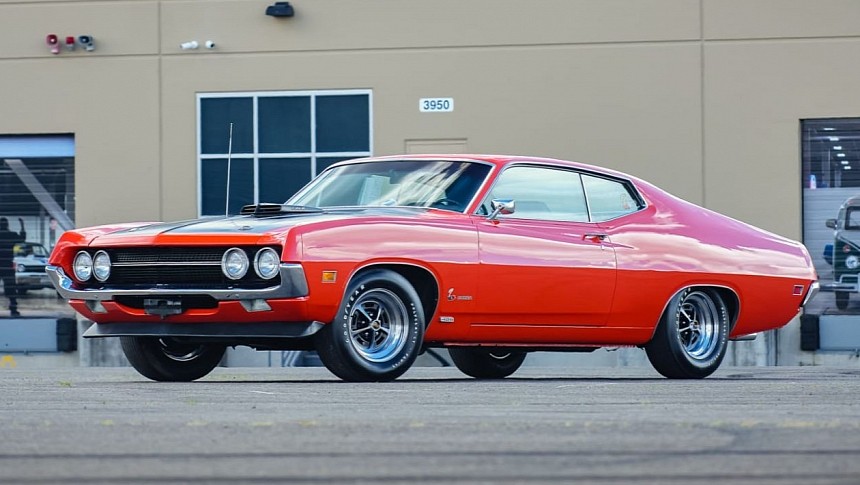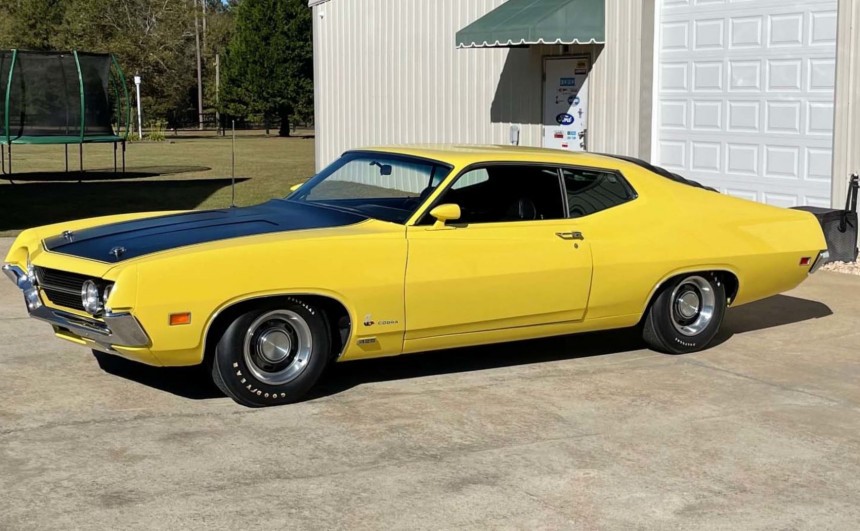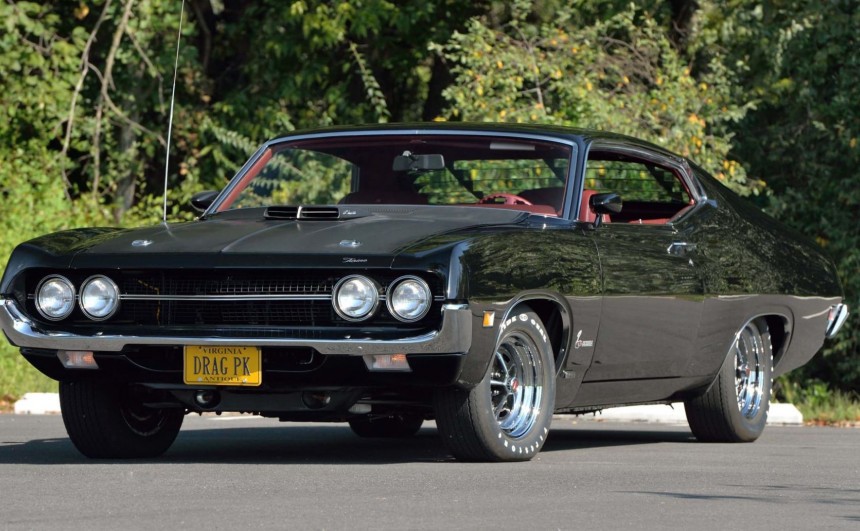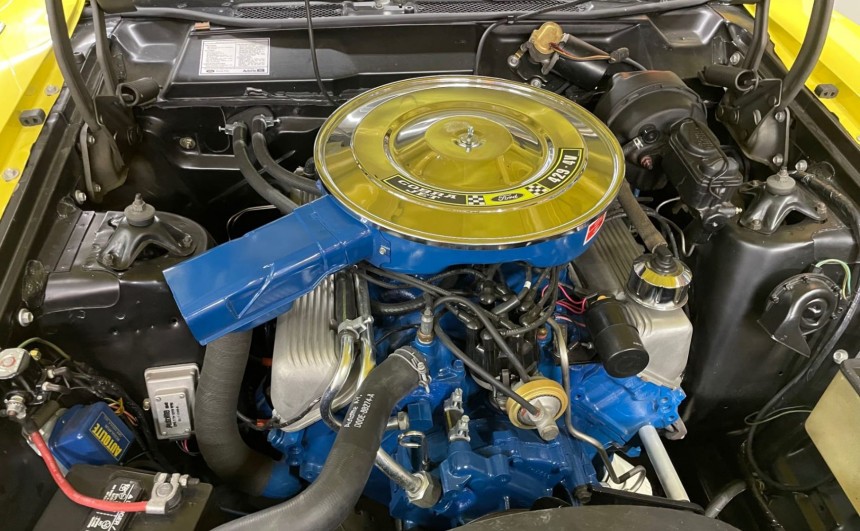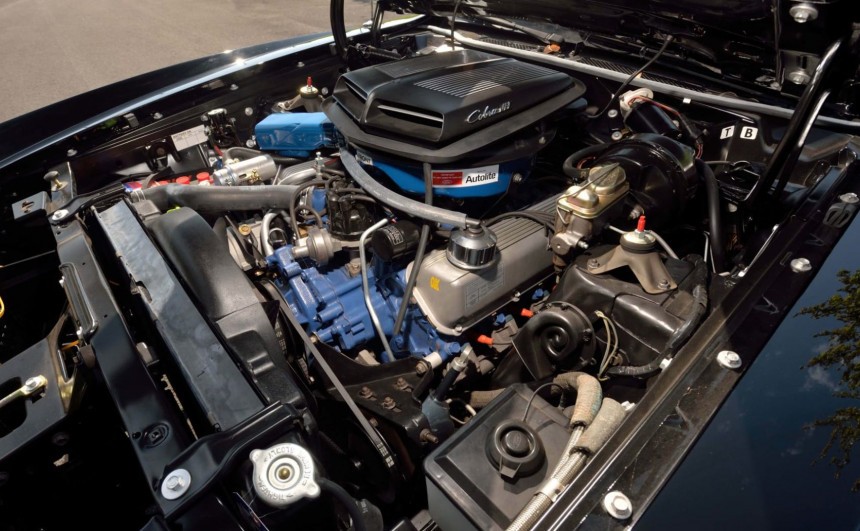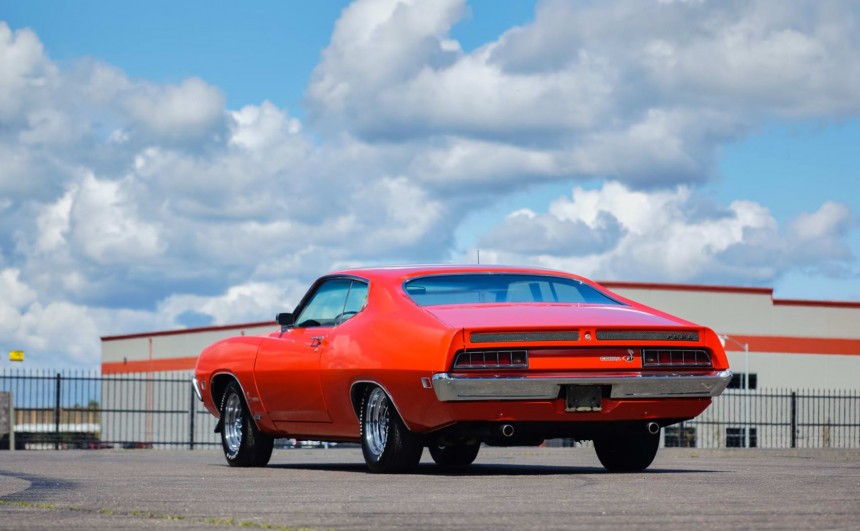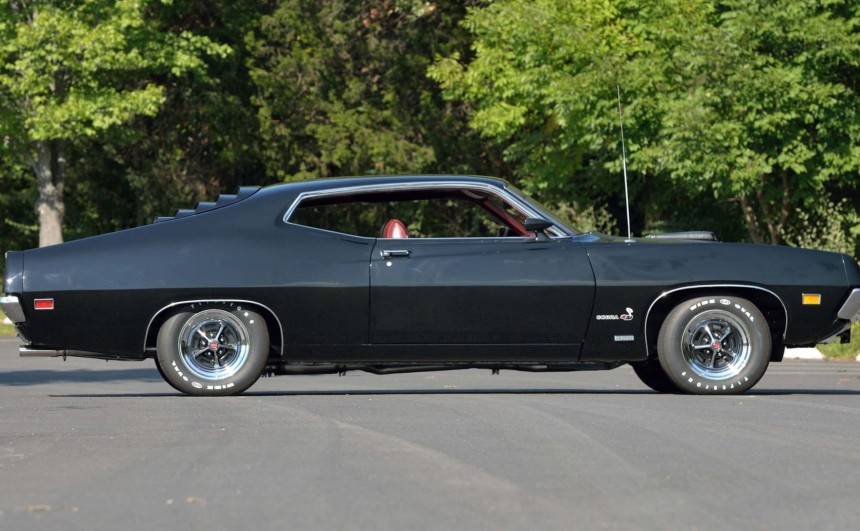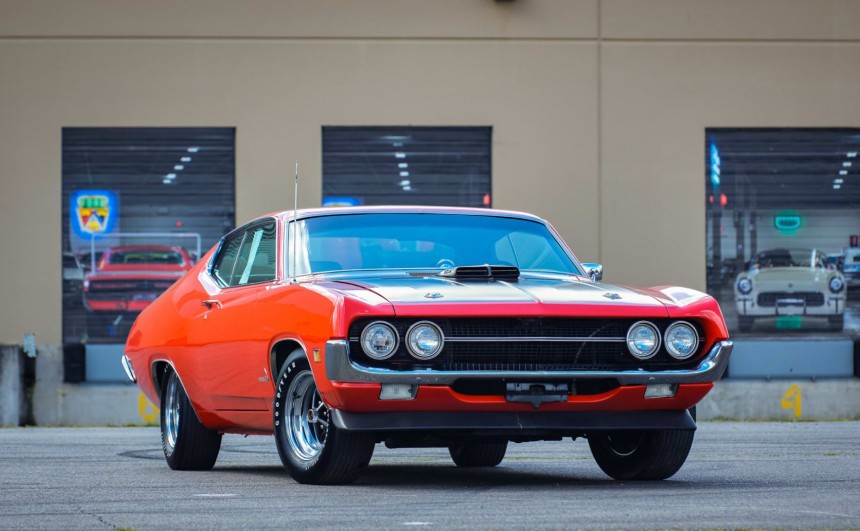While high-performance versions of the first-gen Mustang were (and still are) more popular, let's take a moment and remember the Blue Oval's ultimate street fighter from the golden age of muscle cars.
Retired in 1976, the Torino nameplate (inspired by the Italian city of Turin) debuted in 1968 as the upscale version of the Fairlane series.
In GT or Cobra guises equipped with top engine options, the 1968-1969 Torino was Ford's answer to the era's most potent intermediates.
On the track, the 1968 Torino SportsRoof (aka fastback) and 1969 Talladega helped Ford and Holman-Moody grab two consecutive NASCAR Grand National Series titles.
These achievements helped boost Torino sales for the first two model years and convinced Ford to redesign its intermediate star for 1970.
Though the redesign ultimately cost the company a third NASCAR title, it helped boost sales even further, earned the model MotorTrend's Car of the Year award, and gave birth to the coolest, most potent Ford-badged muscle cars of the era.
Like the entire Torino/Fairlane line, the 1970 Torino Cobra received a completely new, coke bottle-inspired design sketched out by Ford stylist Bill Shenk.
Longer, lower, and wider than its predecessors, the muscle car's SportsRoof body had a more aggressively flattened fastback roofline and a pointier front end that was subtly wider than the tail - a cue inspired by the fuselage of supersonic aircraft like the SR-71 Blackbird.
Inside, everything was redesigned compared to the previous model, but since the Torino Cobra was a performance-focused model, its cabin wasn't particularly impressive.
As standard, the $3,270 ($25,940 today) Cobra came with vinyl-covered bench seats (front and back), a two-spoke steering wheel, and a redesigned instrument panel, all identical to those of the lesser Torino/Fairlane models.
That being said, customers who wanted something different could equip their Cobras with several available options like individual bucket seats, center console, three-spoke steering wheel, 8,000-RPM tach, or air-conditioning.
Exterior trims Unique to the Torino Cobra were a blacked-out grille, a matte black hood with twist-lock pins, a couple of black honeycomb inserts fitted on the outside of the integrated rear spoiler, and, of course, the famous logos that featured a Cobra on wheels doing a burnout.
Combined with the new-look SportsRoof body, the trims mentioned above made the 1970 model the most aggressive-looking Torino ever built.
But the aggressiveness of the Cobra could be taken up a notch with the addition of the optional $229 Ram Air intake/Shaker hood combo available with the Cobra Jet engines.
As standard, the 1970 Cobra hid a 429 4V 385-Series Thunder Jet 7.0-liter V8 under its hood.
With two-bolt main bearing caps, canted valves, hydraulic lifters, a cast-iron intake manifold with a 600-CFM Autolite four-barrel carb, and a 10.5:1 compression ratio, it was a solid engine rated at 360 hp and 450 lb-ft (610 Nm) of torque.
The standard transmission was a close-ratio four-speed manual with a Hurst shifter, but most owners paid the extra $39 for the three-speed SelectShift Cruise-O-Matic (aka C-6).
Power was sent to the rear wheels through an open 9-inch differential. While that was standard, customers could go for multiple ratio versions of the Traction-Lok limited-slip diff or the drag strip-ready Detroit Locker "No-Spin" version available exclusively with the Drag Pak.
Unlike the stock Torino, the Cobra came standard with heavy-duty springs, shocks, and sway bars. The brakes featured unassisted drums all around, but power-assisted front discs were optionally available.
If the standard engine wasn't enough, the next best thing was a 429-ci (7.0-liter) Cobra Jet.
It featured larger intake and exhaust valves, a higher 11.3:1 compression, and a bespoke intake with a 700-cfm Rochester Quadrajet four-barrel - upgrades that added ten extra horses - but sacrificed 30 lb-ft (40.6 Nm) of torque.
But the option that turned the 1970 Torino Cobra into Ford's most epic street fighter was the $155 Drag Pack.
At the bottom of the 18th page in Torino's dealer brochure, the Drag Pack only referenced a drag-strip-friendly 3.91:1 ring-and-pinion setup and a limited-slip differential.
But only dealers and hardcore hot-rodders knew that the Drag Pack also turned the 429 Cobra Jet into the Super Cobra Jet by adding four-bolt mains, forged aluminum pistons with heavier-duty conrods, a hotter, solid-lifter cam, and a 780-cfm Holley carb.
On paper, the SCJ had the same ratings as the normal CJ, but when the Cobra was put on a dyno, the engine delivered over 400 hp.
Moreover, the SCJ was an excellent platform for hott-orders, which could easily extract over 450 hp with just a few bolt-on aftermarket upgrades.
When equipped with the Drag Pack, the Torino Cobra could run the quarter mile in 13.70 seconds at 106 mph, which was not only faster than the more expensive Boss 429 Mustang but faster than most 1970 muscle cars.
That's saying a lot, considering that 1970 was the model year when ridiculous performance peaked and some of the most legendary muscle cars of all time were introduced.
Apart from speed, the Torino Cobra also handled surprisingly well. With the solid suspension upgrades, it was more planted to the road, mainly through corners.
Sure, there was plenty of body roll, and the rear end would easily slight out when the throttle was abused, but it did so, allowing the driver to maintain control at all times.
Even today, the wild yet tamable nature of the Torino Cobra is highly addictive and a big reason why many muscle car enthusiasts chose it over more powerful high-performance models from the same era.
As I mentioned at the beginning of this article, the 1970 redesign cost Ford a third NASCAR title. That's because the new SportsRoof body was less aerodynamically efficient than the preceding design.
Upon realizing this, a talented team of designers led by Larry Shinoda proceeded to redesign the whole front end of the car to attain an aerodynamic edge.
The resulting prototype called Torino King Cobra was set to debut during the 1970 NASCAR season and to gain homologation, a limited run of street-legal versions was scheduled.
The initial plan was to make the King Cobra available with a wide range of V8s, including the CJ, SCJ, and Boss 429s. With those engines and the aerodynamic enhancements, the road-going version of FOrd's latest aero car would have probably been the fastest muscle car in existence.
Unfortunately, the whole project was canceled, and Plymouth dominated NASCAR that season with its new Superbird.
Ford sold 7,675 Torino Cobras during the 1970 model year. Out of those, just 1,475 were equipped with the Drag Pack.
Despite being as potent (with the Drag Pack) and aggressive-looking as 1970 intermediate icons like the HEMI Road Runner, Chevelle SS 454 L6, or Buick GSX, the Torino Cobra is currently cheaper.
A surviving example in great shape equipped with the standard 429 can be had for around $50,000, while a rare, Drag Pack-equipped car usually goes for twice as much.
Though for many enthusiasts, the 1967 Shelby GT500 or the 1969-1970 Boss 429 Mustang remain the best Ford muscle cars of the golden age, the 1970 Torino Cobra was undoubtedly better.
For more on this underrated legend, we recommend watching the YouTube video below by MuscleCarOfTheWeek.
In GT or Cobra guises equipped with top engine options, the 1968-1969 Torino was Ford's answer to the era's most potent intermediates.
On the track, the 1968 Torino SportsRoof (aka fastback) and 1969 Talladega helped Ford and Holman-Moody grab two consecutive NASCAR Grand National Series titles.
These achievements helped boost Torino sales for the first two model years and convinced Ford to redesign its intermediate star for 1970.
Though the redesign ultimately cost the company a third NASCAR title, it helped boost sales even further, earned the model MotorTrend's Car of the Year award, and gave birth to the coolest, most potent Ford-badged muscle cars of the era.
Completely new inside-out
Longer, lower, and wider than its predecessors, the muscle car's SportsRoof body had a more aggressively flattened fastback roofline and a pointier front end that was subtly wider than the tail - a cue inspired by the fuselage of supersonic aircraft like the SR-71 Blackbird.
Inside, everything was redesigned compared to the previous model, but since the Torino Cobra was a performance-focused model, its cabin wasn't particularly impressive.
As standard, the $3,270 ($25,940 today) Cobra came with vinyl-covered bench seats (front and back), a two-spoke steering wheel, and a redesigned instrument panel, all identical to those of the lesser Torino/Fairlane models.
That being said, customers who wanted something different could equip their Cobras with several available options like individual bucket seats, center console, three-spoke steering wheel, 8,000-RPM tach, or air-conditioning.
The most aggressive-looking Torino of them all
Combined with the new-look SportsRoof body, the trims mentioned above made the 1970 model the most aggressive-looking Torino ever built.
But the aggressiveness of the Cobra could be taken up a notch with the addition of the optional $229 Ram Air intake/Shaker hood combo available with the Cobra Jet engines.
A solid base engine and standard chassis upgrades
With two-bolt main bearing caps, canted valves, hydraulic lifters, a cast-iron intake manifold with a 600-CFM Autolite four-barrel carb, and a 10.5:1 compression ratio, it was a solid engine rated at 360 hp and 450 lb-ft (610 Nm) of torque.
The standard transmission was a close-ratio four-speed manual with a Hurst shifter, but most owners paid the extra $39 for the three-speed SelectShift Cruise-O-Matic (aka C-6).
Power was sent to the rear wheels through an open 9-inch differential. While that was standard, customers could go for multiple ratio versions of the Traction-Lok limited-slip diff or the drag strip-ready Detroit Locker "No-Spin" version available exclusively with the Drag Pak.
Unlike the stock Torino, the Cobra came standard with heavy-duty springs, shocks, and sway bars. The brakes featured unassisted drums all around, but power-assisted front discs were optionally available.
The poorly-advertized option that gave the Cobra superpowers
It featured larger intake and exhaust valves, a higher 11.3:1 compression, and a bespoke intake with a 700-cfm Rochester Quadrajet four-barrel - upgrades that added ten extra horses - but sacrificed 30 lb-ft (40.6 Nm) of torque.
But the option that turned the 1970 Torino Cobra into Ford's most epic street fighter was the $155 Drag Pack.
At the bottom of the 18th page in Torino's dealer brochure, the Drag Pack only referenced a drag-strip-friendly 3.91:1 ring-and-pinion setup and a limited-slip differential.
But only dealers and hardcore hot-rodders knew that the Drag Pack also turned the 429 Cobra Jet into the Super Cobra Jet by adding four-bolt mains, forged aluminum pistons with heavier-duty conrods, a hotter, solid-lifter cam, and a 780-cfm Holley carb.
On paper, the SCJ had the same ratings as the normal CJ, but when the Cobra was put on a dyno, the engine delivered over 400 hp.
Moreover, the SCJ was an excellent platform for hott-orders, which could easily extract over 450 hp with just a few bolt-on aftermarket upgrades.
One of the fastest, best-handling muscle cars of 1970
That's saying a lot, considering that 1970 was the model year when ridiculous performance peaked and some of the most legendary muscle cars of all time were introduced.
Apart from speed, the Torino Cobra also handled surprisingly well. With the solid suspension upgrades, it was more planted to the road, mainly through corners.
Sure, there was plenty of body roll, and the rear end would easily slight out when the throttle was abused, but it did so, allowing the driver to maintain control at all times.
Even today, the wild yet tamable nature of the Torino Cobra is highly addictive and a big reason why many muscle car enthusiasts chose it over more powerful high-performance models from the same era.
It could have been even better
Upon realizing this, a talented team of designers led by Larry Shinoda proceeded to redesign the whole front end of the car to attain an aerodynamic edge.
The resulting prototype called Torino King Cobra was set to debut during the 1970 NASCAR season and to gain homologation, a limited run of street-legal versions was scheduled.
The initial plan was to make the King Cobra available with a wide range of V8s, including the CJ, SCJ, and Boss 429s. With those engines and the aerodynamic enhancements, the road-going version of FOrd's latest aero car would have probably been the fastest muscle car in existence.
Unfortunately, the whole project was canceled, and Plymouth dominated NASCAR that season with its new Superbird.
The 1970 Torino Cobra today
Despite being as potent (with the Drag Pack) and aggressive-looking as 1970 intermediate icons like the HEMI Road Runner, Chevelle SS 454 L6, or Buick GSX, the Torino Cobra is currently cheaper.
A surviving example in great shape equipped with the standard 429 can be had for around $50,000, while a rare, Drag Pack-equipped car usually goes for twice as much.
Though for many enthusiasts, the 1967 Shelby GT500 or the 1969-1970 Boss 429 Mustang remain the best Ford muscle cars of the golden age, the 1970 Torino Cobra was undoubtedly better.
For more on this underrated legend, we recommend watching the YouTube video below by MuscleCarOfTheWeek.
